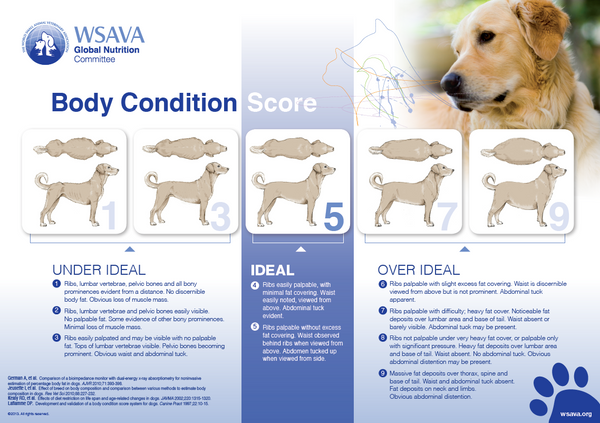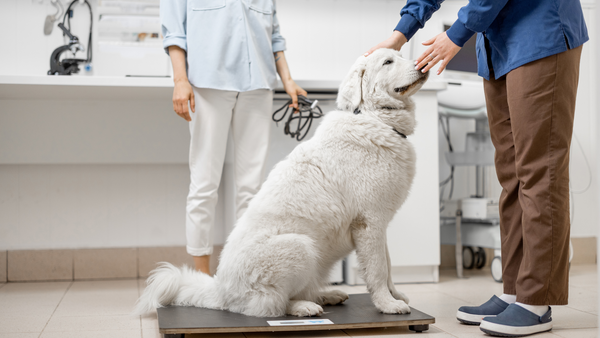
Obesity in Dogs
Obesity in Dogs
In North America, we are currently facing an epidemic of obesity amongst dogs and cats. According to the Association for Pet Obesity Prevention, in 2018 more dogs (60%) and cats (56%) were overweight or obese than were healthy (Ward, 2019). Let that sink in. There are fewer healthy dogs and cats than there are overweight or obese dogs and cats. There are no other adverse health conditions that affect as many of our companion animals as overweight and obesity.

Definition of obesity for companion animals
In companion animals, the term ‘obesity’ has a very strict definition. While the phrase ‘overweight’ can encompass any body composition with more than the ideal 15-20% body fat, obesity is reserved for patients 30% above ideal bodyweight (Ward, German, & Churchill, 2019). The reason for this particular measurement is because 30% overweight is the point at which significant damage occurs to the animal’s body, with functional impairment, various associated diseases and decreased quality of life.

For dogs less than 30% overweight, equivalent to a body condition score of only 6 or 7 on a 9-point scale, chronic diseases may take time to manifest. For example, age-related muscle wasting may be evident 2 years earlier and more severe than in healthy weight dogs, and bone mass may also decrease with age, whereas in healthy weight dogs it may not (Kealy et al., 2002). Arthritis and other chronic health may occur 1 to 2 years earlier in overweight dogs than healthy weight dogs. Indeed, even the lifespan of overweight dogs is 2 years shorter than their lean counterparts. As such, overweight is a serious health condition that impairs both the quality and duration of a dog’s life.
For obese dogs over 30% overweight, equivalent to a body condition score of 8 or 9 on a 9-point scale, comorbidities may be more severe and occur even earlier in life. Conditions more prevalent in obese than lean dogs include: arthritis or other musculoskeletal disease, skin disease, diabetes, lower urinary tract disease, cancer, oral disease, pancreatitis, kidney disease and tracheal collapse(Lund, Armstrong, Kirk, & Klausner, 2006).
Possible causes of obesity

How to keep my dog healthy at a healthy weight

Prevention of overweight and obesity is far easier and safer than curing the condition once it has become established. Regular weight checks and routine scoring of body condition, using a scale like the 9-point WSAVA score (WSAVA, 2013), helps to identify weight gain early. While different breeds and types of dogs will have different body shapes, they all share similar characteristics for fat deposition, making body condition scoring far more robust than relying on visual assessment.
Keeping dogs at a healthy weight improves their quality of life and longevity. They get to live longer, better lives than their overweight or obese counterparts. For dogs who are already overweight or obese, speak with your veterinarian about implementing a weight loss program. The health benefits can be seen very quickly, with some conditions able to be completely reversed or sent into remission simply by losing excess body weight.
References:
Greco, D., Rosychuk, R., Ogilve, G., Harpold, L., & Van Liew, C. (1998). The effect of levothyroxine treatment on resting energy expenditure of hypothyroid dogs. Journal of Veterinary Internal Medicine, 12, 7-10.
Kealy, R., Lawler, D., Ballam, J., Mantz, S., Biery, D., Greeley, E., . . . Stowe, H. (2002). Effects of diet restriction on life span and age-related changes in dogs. Journal of the American Veterinary Medical Association, 220, 1315-1320.
Lund, E., Armstrong, P., Kirk, C., & Klausner, J. (2006). Prevalence and Risk Factors for Obesity in Adult Dogs from Private US Veterinary Practices. International Journal of Applied Research in Veterinary Medicine, 4(20).
Ward, E. (2019). U.S. pet obesity rates plateau and nutritional confusion grows. Retrieved from https://static1.squarespace.com/static/597c71d3e58c621d06830e3f/t/5c86da47c83025a824d387ae/1552341575308/2018+APOP+Survey+Press+Release.pdf
Ward, E., German, A., & Churchill, J. (2019). The Global Pet Obesity Initiative Position Statement. Retrieved from https://static1.squarespace.com/static/597c71d3e58c621d06830e3f/t/5da311c5519bf62664dac512/1570968005938/Global+pet+obesity+initiative+position+statement.pdf
WSAVA. (2013). Body Condition Score (Dog). Global Nutrition Toolkit. Retrieved from https://www.wsava.org/WSAVA/media/Arpita-and-Emma-editorial/Body-Condition-Score-Dog.pdf
